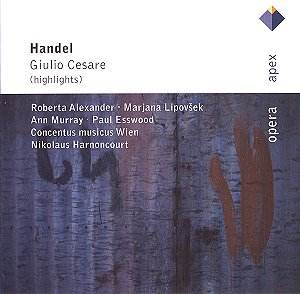Premiered on 20 February,
1724 at the King’s Theatre, Haymarket,
Giulio Cesare stands as one of
the most important operas from Handel’s
prolific pen. As Silke Leopold’s liner
notes explain, this opera cinched an
extremely important victory for Handel.
As one of three resident composers of
the "Royal Academy of Music"
(a joint-stock company founded by several
noblemen under the auspices of the King),
Handel found himself in severe compositional
competition with Giovanni Bononcini.
In fact, a comparison of both composer’s
settings of the Serse story shows them
to be not only competitors but liberal
"borrowers" of each other’s
musical ideas. It was with Giulio
Cesare that Handel succeeded in
formally defeating Bononcini — after
its success, the Italian composer left
the Royal Academy.
This recording truly
presents some of this exquisite opera’s
finest moments. Most of the major arias
are represented in impeccable form.
Harnoncourt leads the Concentus musicus
Wien beautifully — they play sensitively
and with great spirit. The ritornelli
are delivered according to the Affekt
of the aria. Most impressively,
each ritornello is phrased and shaped
according to the text that is to be
subsequently sung to it. This creates
an incredible cohesiveness as the strong
and weak syllables are brought out in
the orchestra before the singer even
begins to sing the text. Tempi are appropriate
throughout the recording with only one
exception. Cesare’s first aria,
Presti omai l’Egizia terra, seems
a bit slow and laborious.
The roster of singers
on this disc reads like an All-Star
list, and the performances contained
here certainly do justice to their reputations.
Paul Esswood, in the title role, gives
an above par performance. It is unfortunate,
however, that his singing is the least
impressive on the disc. As stated earlier,
the tempo in his first aria seems a
bit slow. Surely, this contributes to
the occasionally unfocused tone. The
biggest problem, however, is that here
his voice lacks the virility and chutzpah
the character requires.
Handel’s musical characterization
of Cleopatra stands as an accomplishment
in and of itself. Her exotic origins
are reflected brilliantly in her music
— her arias are set in many "exotically"
sharp keys. In consideration of 18th
century temperaments, these keys would
have pushed the limits of tuning, giving
aural representation of her "otherness."
Harnoncourt takes this further in some
places. His arrangement of continuo
instruments in Cleopatra’s Act
Two aria, Se pieta di me non senti,
is unlike anything else on the recording.
It is an immensely beautiful nine minutes
that is not to be missed. Roberta Alexander
executes this role with intense psychological
insight and a generous helping of heavenly
singing. Her Act Three aria, Da tempeste
il legno infanto, is a coloratura
tour de force. Her performance
leaves little to be desired: melismatic
passages are clear and artistic, the
entire gamut of her considerable range
rings clearly and uniformly, the text
is delivered with utmost intelligibility,
and, as though this weren’t enough,
her cadenzas could rival an Olympic
gymnastics team in acrobatic prowess.
Ann Murray as Seste
and Marjana Lipovšek as Cornelia
round this recording off well. Murray’s
rendition of Svegliatevi nel core
and the recitative that precedes it
are delivered just as a vengeance aria
should be. She sings passionately and
brazenly. Her singing of the aria’s
middle section carries superb contrast
of color and sentiment that allows the
da capo to shock the listener
all over again with its agitation and
fury. Murray’s voice is an incredible
instrument. This short aria requires
technical and expressive extremes, and
she meets the challenge head-on.
This recording must
stand out as one of the best representations
of one of Handel’s most successful operatic
ventures. My only hope is that a full
recording of this cast will one day
be available. This one hour compilation
of highlights goes by all too quickly.
Jonathan Rohr
[There is a recommended
complete opera on DVD see review]







